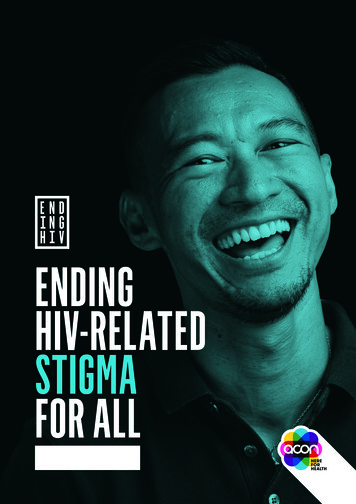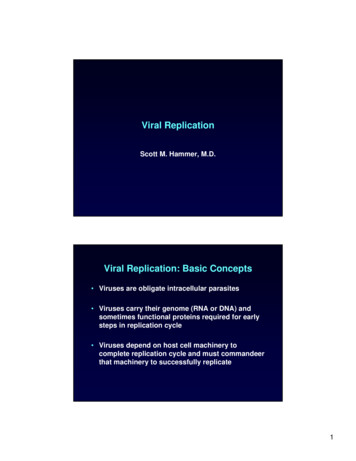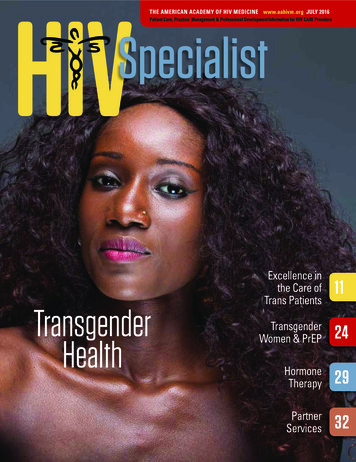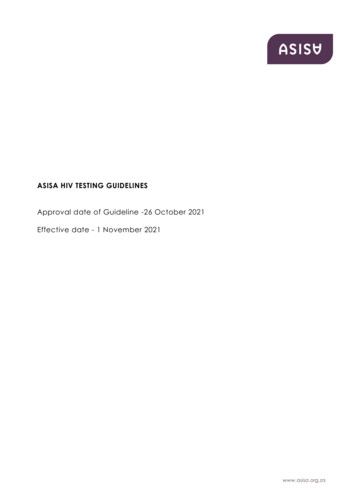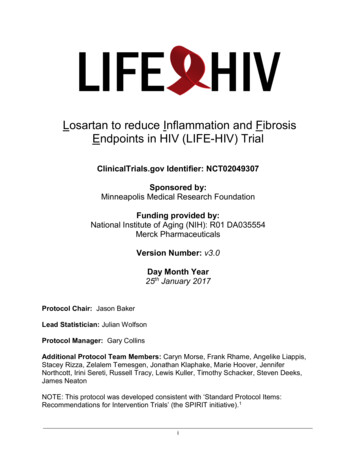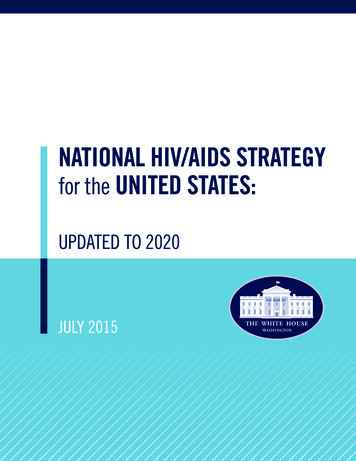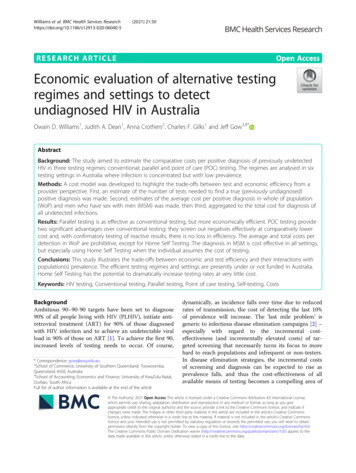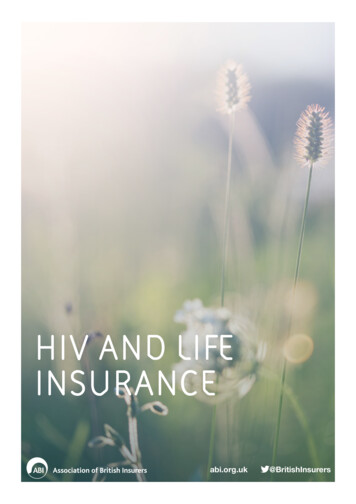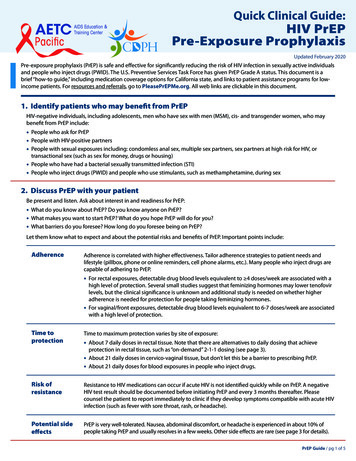
Transcription
Quick Clinical Guide:HIV PrEPPre-Exposure ProphylaxisUpdated February 2020Pre-exposure prophylaxis (PrEP) is safe and effective for significantly reducing the risk of HIV infection in sexually active individualsand people who inject drugs (PWID). The U.S. Preventive Services Task Force has given PrEP Grade A status. This document is abrief “how-to guide,” including medication coverage options for California state, and links to patient assistance programs for lowincome patients. For resources and referrals, go to PleasePrEPMe.org. All web links are clickable in this document.1. Identify patients who may benefit from PrEPHIV-negative individuals, including adolescents, men who have sex with men (MSM), cis- and transgender women, who maybenefit from PrEP include: People who ask for PrEP People with HIV-positive partners People with sexual exposures including: condomless anal sex, multiple sex partners, sex partners at high risk for HIV, or transactional sex (such as sex for money, drugs or housing)People who have had a bacterial sexually transmitted infection (STI)People who inject drugs (PWID) and people who use stimulants, such as methamphetamine, during sex2. Discuss PrEP with your patientBe present and listen. Ask about interest in and readiness for PrEP: What do you know about PrEP? Do you know anyone on PrEP? What makes you want to start PrEP? What do you hope PrEP will do for you? What barriers do you foresee? How long do you foresee being on PrEP?Let them know what to expect and about the potential risks and benefits of PrEP. Important points include:AdherenceAdherence is correlated with higher effectiveness. Tailor adherence strategies to patient needs andlifestyle (pillbox, phone or online reminders, cell phone alarms, etc.). Many people who inject drugs arecapable of adhering to PrEP. For rectal exposures, detectable drug blood levels equivalent to 4 doses/week are associated with a Time toprotectionhigh level of protection. Several small studies suggest that feminizing hormones may lower tenofovirlevels, but the clinical significance is unknown and additional study is needed on whether higheradherence is needed for protection for people taking feminizing hormones.For vaginal/front exposures, detectable drug blood levels equivalent to 6-7 doses/week are associatedwith a high level of protection.Time to maximum protection varies by site of exposure: About 7 daily doses in rectal tissue. Note that there are alternatives to daily dosing that achieve protection in rectal tissue, such as “on-demand” 2-1-1 dosing (see page 3).About 21 daily doses in cervico-vaginal tissue, but don’t let this be a barrier to prescribing PrEP.About 21 daily doses for blood exposures in people who inject drugs.Risk ofresistanceResistance to HIV medications can occur if acute HIV is not identified quickly while on PrEP. A negativeHIV test result should be documented before initiating PrEP and every 3 months thereafter. Pleasecounsel the patient to report immediately to clinic if they develop symptoms compatible with acute HIVinfection (such as fever with sore throat, rash, or headache).Potential sideeffectsPrEP is very well-tolerated. Nausea, abdominal discomfort, or headache is experienced in about 10% ofpeople taking PrEP and usually resolves in a few weeks. Other side effects are rare (see page 3 for details).PrEP Guide / pg 1 of 5
3. Take a medical, sexual, substance use history and review of symptomsCheck for: HIV exposures in the prior 72 hours; if present, offer post-exposure prophylaxis (PEP): ebgtz.org/resource/pep-guide Recent symptoms of a mono-like illness (fever with sore throat, rash or headache): if present, test for acute HIV (order an HIV RNA PCR viral load and an HIV 4th generation Ag/Ab test) and consider deferring PrEP until test results are back.Any history of renal disease, liver disease, or osteoporosis, which impacts which PrEP agent is selected. Please see page 3.Willingness and ability to take a medication on a schedule and return for regular appointments and labs while taking PrEP.4. Obtain baseline testingHIV test:HIV antibody test(4th gen Ag/Abrecommended) /- HIV RNA testSerum Creatinine(e.g. as part of abasic or completemetabolic panel)All patients need a negative HIV antibody test (4th generation Ag/Ab recommended) prior toinitiation of PrEP. In patients with acute HIV symptoms or who report a possible HIV exposure in thelast month, test with both an HIV RNA PCR viral load and an HIV 4th generation Ag/Ab test. If thepatient has confirmed positive result, disclose and start HIV treatment or refer to an HIV provider assoon as possible; Truvada or Descovy alone is inadequate therapy for HIV infection.Estimated GFR or CrCl by serum labs should be 60 ml/min (Cockcroft-Gault) to safely use Truvada and 30 ml/min to safely use Descovy . An online calculator can be found here: tinyurl.com/CrClcalculatorHepatitis B surface Truvada and Descovy are active against hepatitis B virus (HBV). Patients with chronic HBV can useeither agent for PrEP but should have liver function tests monitored regularly during PrEP use andantigen (HBsAg)after discontinuing PrEP; hepatitis can flare if PrEP is discontinued. Patients who are HBsAg negativeshould be offered HBV vaccination if not previously infected or immunized.Hepatitis CantibodyDetermine baseline hepatitis C infection status and obtain repeat testing at least yearly amongMSM, PWID and others with ongoing exposures.STIs (based onTest patients on PrEP for syphilis and for urethral, rectal, and pharyngeal GC and CT based onreported exposure routes (not based on gender/sexuality) every 3 months. Consider using selfcollected swabs for GC/CT testing. Consider offering the HPV and hepatitis A virus (HAV) vaccines ifnot previously vaccinated.Pregnancy testPeople who can become pregnant (reproductive-age cisgender women, some transgender menand non-binary people) should receive a pregnancy test and have contraception plans reviewed.In patients trying to conceive, PrEP should be coordinated with prenatal care with attention to thepatient’s reproductive and breastfeeding plans. Descovy is NOT approved for use as PrEP in thispopulation. Perinatal HIV/AIDS consultation is available at 888-448-8765.sexual exposures)(when appropriate)5. Initiate PrEPIf there are no contraindications and the patient wants to use PrEP, PrEP can be initiated: Same-day PrEP prescriptions are encouraged when possible. The California Office of AIDS and Pacific AIDS Educationand Training Center strongly encourage writing a prescription and starting PrEP on the same day a patient comes in forconsultation when:» the patient has a negative HIV test within the last 2 weeks and no HIV exposures since this test,» all laboratory testing is obtained that day, and» the patient has no symptoms of acute HIV infection.If it has been more than 2 weeks since baseline labs were obtained, repeat an HIV test and start PrEP the same-day whileawaiting results of the repeat HIV test. To transition from PEP to PrEP, check an HIV 4th gen Ag/Ab test while on week 4 of PEP and prescribe PrEP so the patient can startPrEP the day after PEP is completed. Confirm that the HIV testing done during week 4 of PEP is negative.PrEP Guide / pg 2 of 5
6. Select PrEP MedicationThere are two agents FDA-approved for PrEP, Truvada and Descovy , which are both safe and highly effective in clinical trials.There were no differences in adverse clinical outcomes such as broken bones or heart disease between people taking eitherdrug. Choice may be limited by insurance coverage; Medi-Cal covers both.PrEP medicationTruvada Descovy Tenofovir disoproxil fumarate 300 mg Emtricitabine 200 mg (F/TDF)Tenofovir alafenamide 25 mg Emtricitabine 200 mg (F/TAF)IndicationsTruvada is approved for use for all adults andadolescents 35 kg with indications for PrEP.Descovy is approved for use for adultsand adolescents 35 kg at risk for sexuallyacquired HIV, excluding individuals at riskonly from receptive vaginal/front hole sex oronly from injection drug use.Dosing1 pill once dailyunless using a PrEP 2-1-1 schedule“On-Demand” PrEP:2-1-1 dosingNote that while there issubstantial published datasupporting this strategyfor MSM, it has not beenreviewed by the FDA orrecommended by the CDC.The International AIDSSociety of the US (IAS-USA),World Health Organization(WHO), and European AIDSClinical Society (EACS) allendorse the option of thisdosing strategy.2-1-1 for MSM with anal exposures only:2 pills 2-24 hours before anal sex(24 hours before for optimal protection)- then 1 pill 24 hours after first dose- then 1 pill 24 hours after second dose. If there is another exposure within 7 days ofthe last dose, take 1 pill 2-24 hours beforeanal sex, then 1 pill 24 hours after first dose,then 1 pill 24 hours after second dose. If there are continued daily sexualexposures, continue 1 pill daily until48 hours has passed since last sexualencounter.For a detailed 2-1-1 guide, go to:tinyurl.com/HIVPrEP211.1 pill once dailyThe PrEP 2-1-1 dosing schedule is notrecommended for use with Descovy outsideof a clinical trial.Side effectsGenerally safe and well tolerated Headache (7%) and abdominal discomfort(3%), which often resolve in a few weeks Small decrease in eGFR, which improvesupon discontinuation of Truvada Slightly decreased bone density, but noincreased risk of fracturesGenerally safe and well tolerated Abdominal discomfort, nausea (5%) andheadache (2%), which often resolve in afew weeks Small increase in LDL cholesterol Slight increase in body weightOther notesEstimated GFR or CrCl by serum labs shouldbe 60 ml/min (Cockcroft-Gault) to safely useTruvada .A generic form of Tenofovir disoproxilfumarate Emtricitabine (F/TDF) isanticipated in October 2020.Estimated GFR or CrCl by serum labs shouldbe 30 ml/min (Cockcroft-Gault) to safely useDescovy . Provide adherence counseling and anticipatory guidance about common side effects. Discuss patient strategies for daily adherence. Counsel patients on risk reduction using condoms with PrEP to decrease transmission of STIs.PrEP Guide / pg 3 of 5
7. Monitor and provide ongoing support for patients using PrEPMonitoring recommendations are currently identical for Truvada and Descovy as well as for people using 2-1-1 dosing.TimeframeAction30 days after initiation Assess for:» Side effects and patient interest in continuing.» Adherence: link to regular habits, set reminders, reinforce importance of An in-person follow-up visit is highly recommended for patients24 years old and under or thosewho may have difficulties withadherence.A phone call is a reasonablealternative for other patients.dosing schedule, and address any challenges the patient has faced.» Ongoing risk: provide risk reduction counseling.» Signs and symptoms of acute HIV infection. Prescribe an additional 60-day supply with no refills. At visit: adherence and risk reduction counseling. HIV test: 4th generation antigen/antibody test preferred. Serum Creatinine: stop if eGFR declines. STI screening: syphilis and for urethral, rectal, and pharyngeal GC and CT basedEvery 3 months Labs Visit Refills on reported exposure routes (not based on gender/sexuality). Consider usingself-collected swabs for GC/CT testing.Pregnancy test for appropriate patients.Prescribe a 90-day supply if HIV test negative at each visit. Hepatitis C antibody, particularly for MSM and PWID.Every 12 months or moreoften based on exposures8. What if my patient tests positive for HIV while on PrEP?a. Discontinue PrEP to avoid development of HIV resistanceb. Start patient on HIV antiretroviral treatment as soon as possible in accordance with HIV Treatment Guidelines (tinyurl.com/HIVTreatmentGuidelines), and/or facilitate a warm hand-off referral to an HIV provider immediately.c. For questions and support, call the National HIV Clinicians Consultation Center: 800-933-4313.d. Order HIV genotype and document results.e. Report the test result to your local health department.9. PrEP coverage options:Insured patients Prior authorizations (PAs) for Truvada are no longer allowed in California after January 2020. Many private insurers cover PrEP.» Adolescents covered on their parents’ plan can keep their info confidential by signing up at myhealthmyinfo.org. For Medi-Cal prescriptions, we recommend writing a note to the pharmacy to “bill the Medi-Cal HIV carve-out directly and not the managed-care plan” to ensure Medi-Cal coverage.» For adolescents, the Medi-Cal Minor Consent Program can help pay for PrEP/PEP and keep the services confidential. ICD-10 codes for PrEP include:» Z20.6: Contact with and (suspected) exposure to human immunodeficiency virus [HIV]» Z20.2: Contact with and (suspected) exposure to infections with a predominantly sexual mode of transmission» Z71.7: Human Immunodeficiency Virus (HIV) counseling If patient needs help with co-pays, the Gilead co-pay assistance program can provide co-pay assistance for up to 7,200annually for either agent: gileadadvancingaccess.com or 877-505-6986. Other payment assistance programs are listed on the Fair Pricing Coalition website: tinyurl.com/preppricingprogs The California PrEP Assistance Program (PrEP-AP) helps low income [ 500% Federal Poverty Line (FPL)] insured patientspay for PrEP-related out-of-pocket costs, such as medical visits and labs, and also assists with Truvada or Descovy co-paysafter the 7,200 Gilead benefit is exhausted: tinyurl.com/prepapPrEP Guide / pg 4 of 5
Uninsured patients The Gilead Advancing Access PrEP medication assistance program will provide monthly Truvada or Descovy deliveries to the patient or clinic at no cost for those without prescription coverage and who meet income guidelines ( 500% FPL).» Call 800-226-2056 for inquiries or to apply by phone, Monday-Friday, 6am-5pm PST» Fax the completed application and proof of income to 855-330-5478: tinyurl.com/GileadEnrollment» If approved, one bottle (30-day supply) will be available for pickup at any non-Kaiser pharmacy. For pickup, provide anID, bin, group, or PCN number (provided by Gilead). Refills can be coordinated with the pharmacy.» Alternatively, medication bottles may also be shipped to a clinic in 3-14 days. A Gilead representative will call theprovider before the 2nd bottle is sent to confirm refill if continuing to ship to clinic.» Patients must re-apply (i.e. resubmit proof of eligibility) every 12 months.» U.S. and undocumented residents are eligible. Social security numbers are not required. Proofs of income include: W2,1040 tax return, 2 pay stubs from the last 90 days or letter stating monthly income. The letter stating monthly incomeshould include the residence address and must be signed and dated but does not need to be notarized. The Ending the HIV Epidemic: Ready, Set, PrEP program (getyourprep.com) will provide monthly Truvada or Descovy deliveries to the patient or clinic at no cost for those without prescription coverage regardless of income for up to 200,000patients per year. Patients must provide proof of lack of prescription coverage, a recent negative HIV test result, and acurrent prescription for PrEP. The California PrEP-AP program (tinyurl.com/prepap) serves uninsured low-income patients ( 500% FPL) as a payer of lastresort for PrEP-related medical costs (e.g. labs, visits, STI treatment) and must be used in conjunction with the Gilead PatientAssistance Program. Patients are not required to use the Ready, Set PrEP program before enrolling in CA PrEP-AP.Have questions?The national HIV PrEPLine for clinicians provides guidance on PrEP: 855-448-7737Go to PleasePrEPMe for a location-responsive California PrEP provider directory, online chat navigation in English and Spanish,and many resource pages including for patients, providers, youth, trans and non-trans women: pleaseprepme.orgFurther information about PrEP can be found at: PleasePrEPMe PrEP Navigator Manual: pleaseprepme.org/prepnavigatormanual CDC website: cdc.gov/hiv/risk/prep/index.html San Francisco City Clinic’s website: sfcityclinic.org/services/prep.aspAuthors: Stephanie Cohen, MD, MPH; Samali Lubega, MD; Philip Peters, MD; Sophy S. Wong, MDContributors: Al Liu, MD, MPH, Karen Mark, MD, Eric Tang, MD, Christine Kibui, Alan McCord, Shannon Weber, Laura Lazar, JulietStoltey, MD, Juliana Grant, MD, Adrian Barraza, Betsie Cialino, Robert Grant, MD, Shrey Goel, David Gonzalez, Jessica Bloome, MD,Monica Hahn, MDDesign: Querido GaldoThis project was supported by funds received from the State of California, Department of Public Health, Office of AIDS. This project was also supported by theHealth Resources and Services Administration (HRSA) of the U.S. Department of Health and Human Services (HHS) under cooperative agreement #5 U10HA29292,Regional AIDS Education and Training Centers. This information or content and conclusions are those of the author and should not be construed as the officialposition or policy of, nor should any endorsements be inferred by HRSA, HHS or the U.S. Government.Feedback/questions: paetcmail@ucsf.eduPrEP Guide / pg 5 of 5
HIV PrEP Pre-Exposure Prophylaxis Updated February 2020 Pre-exposure prophylaxis (PrEP) is safe and effective for significantly reducing the risk of HIV infection in sexually active individuals and people who inject drugs (PWID). The U.S. Preventive Services Task Force has given PrEP Grade A status. This document is a
